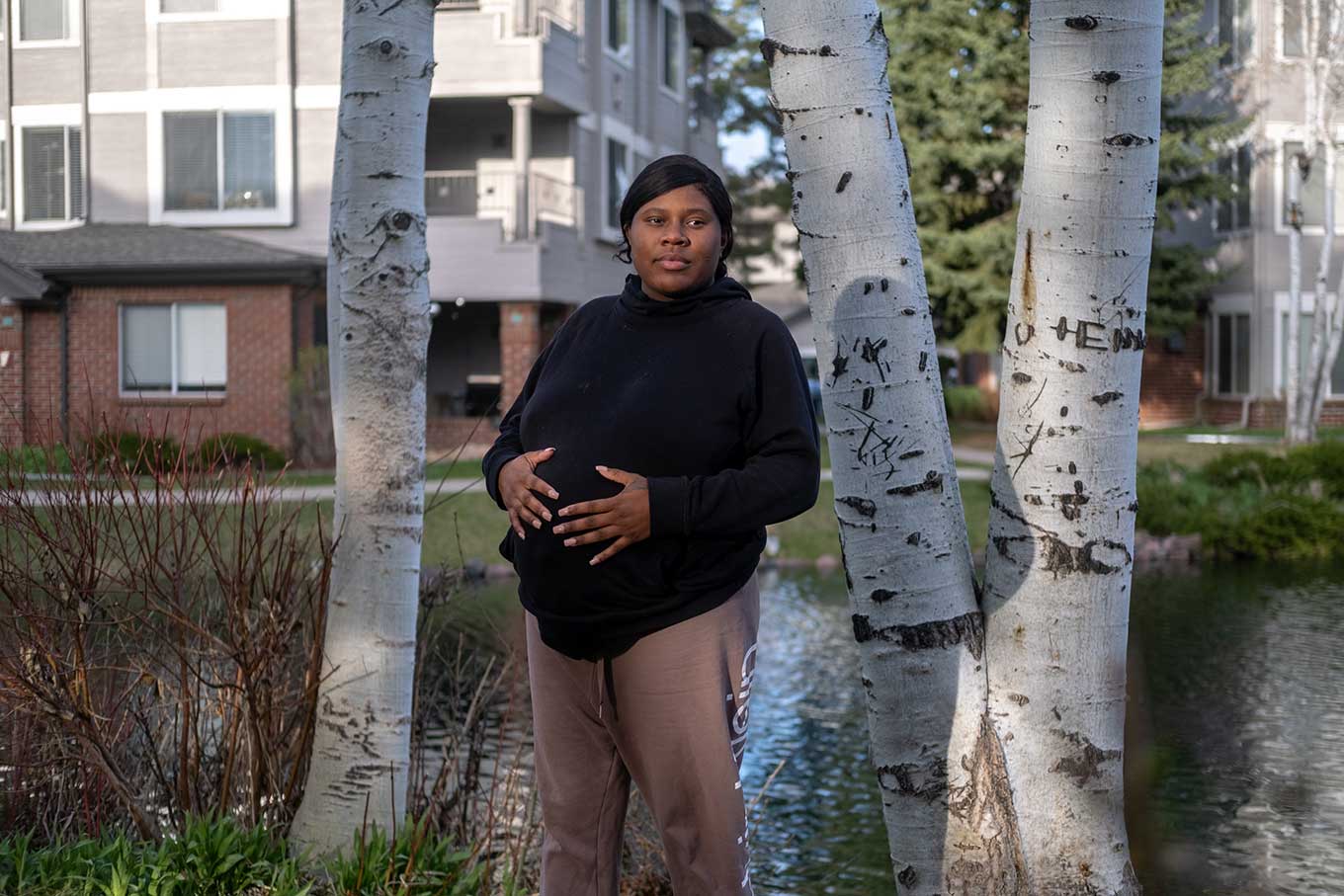
Jaid Redmon-Greene, pregnant with her third child, stands outside her Denver apartment on April 6, 2024. Photo by Eli Imadali / Special to The Colorado Trust
Jaid Redmon-Greene, pregnant with her third child, stands outside her Denver apartment on April 6, 2024. Photo by Eli Imadali / Special to The Colorado Trust
When Jaid Redmon-Greene’s water broke in September of 2021, she went to UCHealth University of Colorado Hospital in Aurora, which delivers about 3,700 babies annually. She and her partner were unhoused during her pregnancy, and Redmon-Greene had been using cocaine and alcohol.
When they arrived at the hospital, Redmon-Greene was in a lot of pain. Her partner, the father of her son, asked for a wheelchair. She said he was told he would have to find one himself.
“He said, ‘Since we’re Black and she’s in a lot of pain and we look the way we do, you’re not going to assist us?’” she recalled. “Someone there told me to ‘Just calm down, calm down, calm down. You’re being dramatic.’”
Redmon-Greene said she wasn’t surprised by the response. She had visited the hospital’s emergency department intermittently throughout her pregnancy but said she was never connected with resources—not housing assistance, substance use treatment or food assistance.
“It seems like I’m bugging them all the time. I’m asking questions. I don’t know how to feel, and I asked for help, and they would just discharge me and not give me any resources, and blatantly just leave me in the streets,” she said. “It was really sad. It was a really horrible pregnancy.”
Once in her delivery room, Redmon-Greene asked for food but was told the cafeteria was closed. She wanted something other than fentanyl for pain management but says she was given the drug anyway. Finally, she delivered her baby, a boy.
Redmon-Greene says that staff asked her if they could take the baby for a bath. She agreed and then dozed off—but when she woke up, her son was gone. A child welfare social worker told Redmon-Greene she had been deemed unsafe and her son was being removed from her care.
A UCHealth spokesperson declined to comment specifically on Redmon-Greene’s account or experience, stating that hospital “social workers, addiction medicine specialists and behavioral health counselors provide broad, wraparound care both before and after the delivery.” The spokesperson also pointed to a housing transition team and a perinatal peer-support doula program available to patients.
In 2021, about 20% of pregnant people nationwide reported substance use during pregnancy, according to the National Survey on Drug Use and Health. Approximately 11% of births that year were affected by prenatal exposure to alcohol, and about 8% were affected by prenatal exposure to illicit drugs.
Pregnant people who use alcohol and illicit substances face magnified barriers to prenatal, postnatal and substance use care. They fear the removal of their child and the risk of facing criminal prosecution for using alcohol or drugs while pregnant.
In the U.S., one in three children will be part of a child welfare investigation by age 18, with 700 kids removed from parental custody daily, according to a September 2023 report by the American Civil Liberties Union. More than 200,000 children enter the foster system each year.
Black and Indigenous families are more likely to be reported and investigated by child welfare than white families, according to the report. As a result, Black children, who comprise 14% of the U.S. child population, make up 24% of child abuse or neglect reports and 21% of children entering the foster system. Black children are also more likely to be removed from their families, remain separated for longer periods, and be legally orphaned by the child welfare system.
“The entire issue of substance use during pregnancy is fully embroiled in stigma and fear,” said Jade Woodard, executive director of Illuminate Colorado, a nonprofit working to address child maltreatment. “There is real fear around what it could mean for the development of your baby. There is real fear around what it can mean around system involvement.”
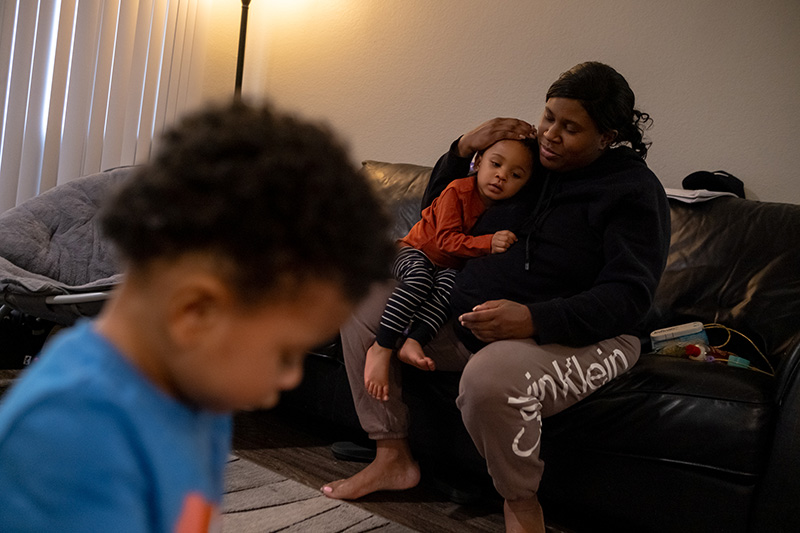
Redmon-Greene’s first child, Michael Parker III (center), now 2, was removed from her custody by child welfare services after she delivered him. She never lost custody of her second child, 1-year-old Jaidan (left), and was fully reunited with Michael in September 2023. Photo by Eli Imadali / Special to The Colorado Trust
Prenatal exposure to alcohol and drugs can have physical, cognitive and socio-emotional impacts on a child’s development from infancy to young adulthood. The effects of substance use depend on a variety of factors, including exposure to one or multiple substances, the timing of exposure in utero and the type of substance. Such exposure can lead to miscarriage, congenital disabilities or developmental disabilities, according to the Centers for Disease Control and Prevention.
Despite these risks to an infant, many experts agree the best course of action is for the pregnant person to receive support and substance use treatment and for the family to stay together, so long as the parent’s substance use doesn’t pose a direct threat to the infant’s well-being. A child welfare social worker typically determines whether there is a direct threat; such a determination can depend on factors like family support, housing status and the parent’s willingness to seek treatment. Research also shows children fare better in their own homes versus foster care.
For families to have a better chance at staying together and for birthing parents to get more access to programs and resources to treat their substance use disorders, Colorado changed its definition of child abuse and created Plans of Safe Care in 2020.
During prenatal care and delivery, medical staff are mandatory reporters under the federal Child Abuse and Prevention Treatment Act. This 1974 law guides states on how to prevent and investigate child abuse and neglect and creates mandates for states to follow to receive funding for child welfare agencies.
In 2016, the federal Comprehensive Addiction and Recovery Act required state child welfare systems to develop Plans of Safe Care for infants affected by substance use, withdrawal symptoms or fetal alcohol spectrum disorder. The federal act does not define “affected by substance use” or require states to follow a standard plan; states must develop their own.
Until 2020, Colorado prenatal substance use and child substance exposure were reported to child welfare by mandatory reporters. That year, a new state law modified how abuse and neglect are determined—now, a child must be “affected by alcohol or substance exposure,” and the newborn child’s “health or welfare is threatened by substance use.”
“Previously, it was basically positive biologic testing equals abuse and neglect,” said Lauren Bruns, MD, assistant professor of pediatrics at the University of Colorado Anschutz Medical Campus. “There could be a birthing person who had been stable on methadone for opioid use disorder, but then that infant would be born and, if tested, would test positive for methadone and thus be classified as abused and neglected.
“I think everyone saw the error in that.”
Bruns was part of a committee convened by the Division of Child Welfare in the Colorado Department of Human Services to help redefine abuse and neglect when the state legislature drafted and considered the new law. Over many meetings, Bruns said the committee came to a broad definition to allow a mandatory reporter to interpret whether an infant may be at risk; this no longer relies on testing as the only measure.
“I think that in evaluating whether a newborn’s health or welfare is threatened by substance use disorder by that caregiver, as defined by when their needs may not be appropriately met, I think that it can just be tough,” Bruns said.
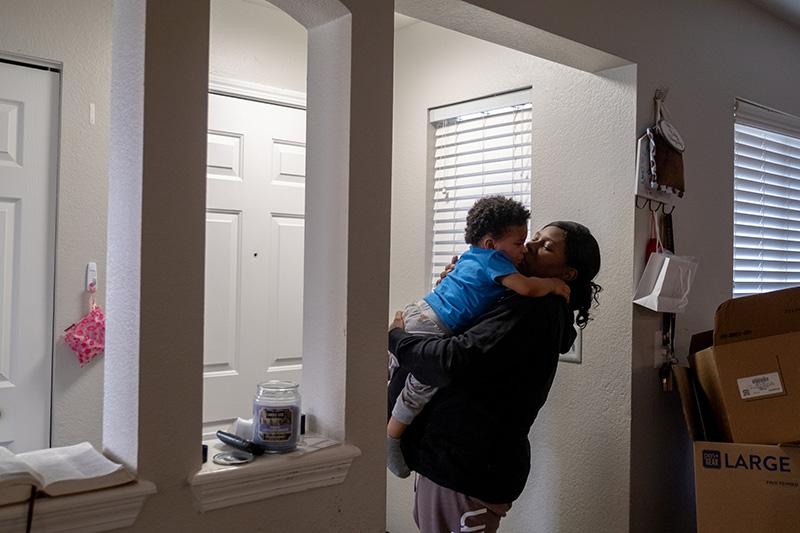
Redmon-Greene holds her son Jaidan at home in Denver. Photo by Eli Imadali / Special to The Colorado Trust
As of August 2023, 25 states and Washington, D.C. still consider substance use during pregnancy to be child abuse, according to the Guttmacher Institute, a reproductive health and policy research group. Those states require health care professionals to report any suspected prenatal drug use to authorities.
Along with the change in the definition of abuse and neglect, the Colorado Department of Human Services developed Plans of Safe Care in partnership with hospitals to help families with substance use disorders create a community safety net. Ideally, the plan is established during prenatal care, before child welfare involvement, and then followed through delivery and into the postpartum period. The plan addresses the physical health of the family; behavioral health, such as treatment plans; infant health and development, including early care and education programs; and parenting support, such as housing or child care plans.
“The family can work with their community partners, they can work with their family members or community resources, the hospital, and they will not necessarily need to be involved with child welfare at all,” said April Jenkins, Child Protection and Prevention Unit manager with the Colorado Department of Human Services.
The Plans of Safe Care are different from the “safety plan” agreements made between the Division of Child Welfare and a family that require the family to do things like seek treatment to maintain or regain custody of their child. To improve Plans of Safe Care, the division is training its caseworkers and working closely with birthing hospitals and community partners to educate them about the plans and ensure they are used well.
“Every family is unique and has its own strengths and challenges, so working with caseworkers to kind of think through how they interact with families, how to identify community services that may be helpful for families in different situations” is important, said Shannon Bryan, a substance use disorder and substance exposed newborn specialist in the Division of Child Welfare. Bryan added that the division is “working with our caseworkers to also better understand the lived experience and expertise of the families that we’re working with, and to understand substance use and addiction and its impact on individuals in the family system.”
However, it can be difficult for hospital staff to enact a Plan of Safe Care in the few days a person is in the hospital to deliver if the plan wasn’t started earlier in pregnancy, according to Kaylin Klie, MD, a UCHealth provider who has long worked in addiction medicine for pregnant and postpartum people. Klie is working to ensure Plans of Safe Care begin before a patient delivers their baby.
“My goal would be that it decreases the trauma of having these discussions right around the time of birth if we’ve already prepared ahead of time,” said Klie, associate director of the Addiction Medicine Fellowship at UCHealth University of Colorado Hospital. “I say to my patients, ‘Child protection asks the same set of questions every single time, so it’s not a mystery.’”
Klie said she discusses treatment options with patients, who else lives with them and whether those people are using substances, and what mental or behavioral health needs the parents or other caregivers may have. If those things are addressed ahead of time, it prepares families not only to make necessary steps toward recovery if they’re ready but also to work with child welfare in the case of a substance-exposed newborn.
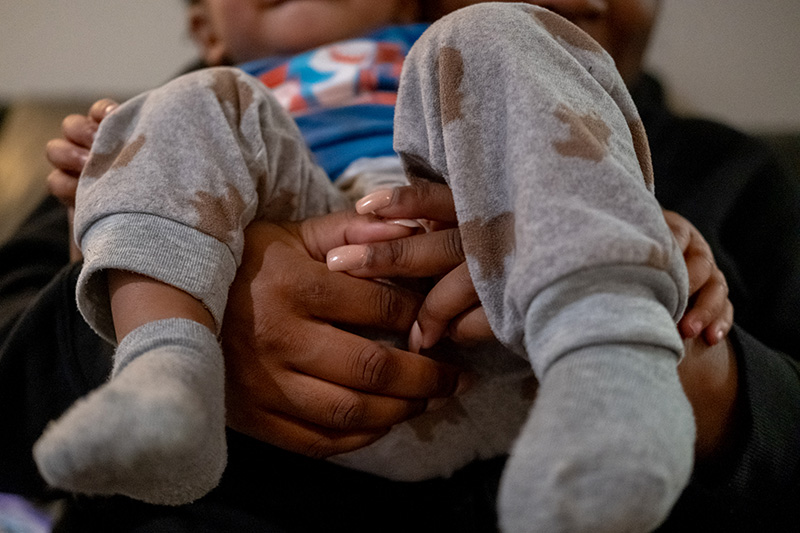
Redmon-Greene worked to treat her addiction and secure housing after her first son was removed from her custody. Despite relapsing during her second pregnancy, she was able to deliver her second son, maintain custody and bring him with her to treatment. Photo by Eli Imadali / Special to The Colorado Trust
In the four years since the state law was enacted, measures of success for Plans of Safe Care remain hard to ascertain, but reports to child welfare have decreased by 25%, according to data from the Colorado Department of Human Services.
From 2020 to 2021, reports of infants exposed to drugs prenatally in Colorado increased about 7%, but then dropped 25% over the next two years, according to the data.
For infants who are exposed to substances and whose families created a Plan of Safe Care but were not reported to child welfare, the plan is not currently tallied by a hospital or the state. This is also true nationally. Families reported to child welfare and that have a Plan of Safe Care are entered into a state tracking system. Still, state officials refused to disclose data from that system, citing the small number of recorded Plans of Safe Care and other “confounding factors.”
State officials did, however, say a pilot program is under development to identify all Plans of Safe Care, regardless of a report to child welfare, as well as study the outcomes of Plans of Safe Care.
“I think it’s fascinating that it’s a federal mandate, but we don’t actually have great published data about outcomes,” Bruns said. She hopes to soon research the Plans of Safe Care results, which she calls the “million dollar question.”
“We’re doing all this, but does it make a difference and is it impactful?” she said.
After her son was removed from her care, Redmon-Greene worked with Arapahoe County Child and Adult Protection Services on a safety plan to try to get him back. She had to go to treatment and was able to get into the New Directions for Families program at Valley Hope treatment center.
Redmon-Greene found out she was pregnant again just a few months after giving birth. She stayed the course, working to treat her addiction and securing housing after New Directions. But in August 2022, she relapsed.
“I knew I messed up. I relapsed like 36 days before delivering,” she said. “I was scared that they were going to take this baby, too, and I couldn’t experience that again.”
Redmon-Greene contemplated fleeing the state before giving birth. Instead, she leaned back into the resources that had helped her get sober after her first son was born. She signed up for sober-living communities to move into after delivering, and this time, she had a supportive care team at Lutheran Medical Center, who she said treated her with dignity and respect.
“They told me I was okay, and they were there for women in recovery. They didn’t treat me differently. … The social worker there at Lutheran was awesome, she didn’t harass me,” Redmon-Greene said. “Then I took [her newborn son] back to treatment with me, and everything was just fine and dandy.”
She never lost custody of her second son. After 18 months of being separated from her first son, she finally regained temporary custody of him in April 2023 and then full custody in September when her child welfare case was closed.

Jaidan Parker and his brother, Michael Parker III (l. to r.), enjoy dinner at home. Photo by Eli Imadali / Special to The Colorado Trust
Redmon-Greene had vastly different experiences between her two deliveries just one year apart. It’s hard to say whether the changes to Colorado’s laws or hospital policies played a role in that change. Still, advocates in the field say they have seen marked changes in patient experience, particularly around bias and stigma in hospitals.
In 2022 and 2023, the Colorado Perinatal Care Quality Collaborative (CPCQC) surveyed labor and delivery unit nursing staff in Colorado hospitals and asked staff to report how their colleagues respond to patients with a substance use disorder, in terms of both attitude and behavior. In both surveys, more than half of respondents said their colleagues display a negative attitude toward such patients. However, only about a third of respondents said this resulted in behavior changes among labor and delivery care providers.
“I have seen a change in the last three and a half years in terms of the awareness of perinatal substance use as an issue among perinatal providers and a reduction of stigma for perinatal substance use,” said Katie Breen, CPCQC’s vice president of programs. “There’s still a ton of stigma, but I do think that it is talked about more and more.”
CPCQC has for years collaborated with Maternal Overdose Matters Plus, a maternal overdose prevention program, and Hard Beauty, an organization that uses peer coaching to help counsel people with substance use disorders, to educate hospital staff on perinatal substance use through training that features people with lived experience of substance use and pregnancy.
The changes in Colorado have primarily focused on birth parents and substance use treatment. Still, hospitals have also made changes to improve treatment and support for substance-exposed infants. In 2017, practitioners from hospitals across the state formed the Colorado Hospitals Substance Exposed Newborns Collaborative (CHoSEN), a statewide initiative to improve methods, transparency, and sharing of best practices for the care of substance-exposed newborns.
Perhaps most significantly, hospitals in this collaborative have shifted away from using methadone or other drugs to help opioid-exposed newborns’ withdrawal and instead rely on a model known as “eat, sleep, console.” If a baby can’t eat more than an ounce of formula or breastmilk, can’t sleep more than an hour uninterrupted or can’t be consoled after 10 minutes, then they need treatment—but instead of pharmacologic therapy, the baby receives comfort measures that ideally a parent provides. Treatment can look like more skin-to-skin contact, on-demand feeding or simply dimming the lights, all measures meant to reduce stimulation and increase comfort for the newborn.
“I think so often our birthing individuals with substance use disorders were often treated disrespectfully and noncentral to the care of their own infants after birth,” said Susan Hwang, MD, PhD, MPH, who founded CHoSEN and is a neonatologist at Children’s Hospital Colorado. “I think what ‘eat, sleep, console’ and CHoSEN QIC [the group’s quality improvement collaborative] really did was change the paradigm in terms of what is the role of the birthing individual in that birth hospital care of the baby.”
Today, Redmon-Greene has more than a year of sobriety and an apartment of her own. She has custody of her sons, who are now 1 and 2 years old. She’s a full-time caretaker of her older son, who developed a swallowing disorder while he was in foster care, and she spends time speaking at treatment facilities and to women’s groups about her experience to help other women navigate their way through addiction and parenting.
“My main focus is that I have my kids, and that I’m okay,” she said. “I want to help other ladies in my situation.”
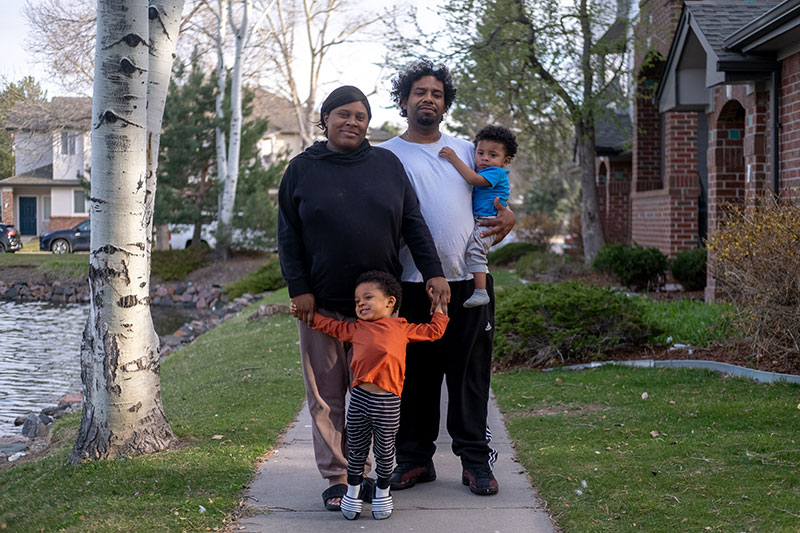
Redmon-Greene with her partner, Michael Parker Jr., and their sons outside their Denver apartment. Photo by Eli Imadali / Special to The Colorado Trust
Part 1 in series: As Opioid Epidemic Worsens in Colorado, Pregnant and Postpartum People Are Dying
Part 3 in series: Inpatient Substance Treatment Centers Can Be Life-Saving for Pregnant People, but There Aren’t Enough Facilities